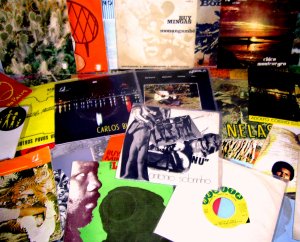A low ref#, MPA-4002 to be precise, leads people to believe that this was one of Merengue’s first singles, presumably released in 1974-75. But you only have to listen to what the band is singing about to realize it just couldn’t be. The a-side is a dedication to a FAPLA (the People’s Armed Forces for the Liberation of Angola) leader – José Mendes de Carvalho, known as Hoji Ya Henda – dead in combat against the Portuguese army, so no way the Portuguese censors would allow that one to pass. And the b-side, “Não ao Tribalismo”, is all about praising other commanding officers (Valódia, Gika, etc) and, of course, president Agostinho Neto, while criticizing tribalism, capitalism, imperialism, federalism, etc, and calling for unity. One of its ironies: it is sung in Portuguese – not only as means of entitlement but also as a way to exhort national identity.
Fans of classic Congolese music of the 60s and 70s will indubitably recognize where A Voz d’África and its leader, Othis Mbembay, were coming from. Like many of the Cabinda bands (Super Coba, Cabinda Ritmo, Bela Negra, etc) and singers (Matadidi Mário, Pépé Pepito, Nonó Manuela, etc), they were actually Angolan expats, refugees and immigrants in DR Congo. Mbembay was also a member of the famous Inter-Palanca band, led by Matadidi and also including Diana Simão Nsimba (a former member of Sam Mangwana’s Festival des Maquisards and Tabu Ley’s African Fiesta National). Mbembay and Simão would also form Os Malucos and Olímpia in the mid-seventies. So this is part of a very interesting narrative: the way in which the Congolese sound influenced Angola’s post-independence music. There’s a compilation here, for sure.
Short-lived, like many bands in the day, A Voz d’África included a typical Congolese line-up: a lead singer and three backing vocalists harmonizing (Diwidi-Andre, Adolfo-Bunga, ‘Drolly’ Pedro and Domingos Bento), bass (Theodór), percussion (Paulo ‘Prince’ and Manuelito Boal) and dueling guitars (Nsukami N’Dombasi on rhythm and Mbembay soloing).
Listen up!
[This post is dedicated to the Likembe blog]
Note: I took these band credits from another A Voz d’África single, “Kumba” (MPA-4053), but the sleeve was so worn that I’m not really sure of the spelling; and there’s always the possibility of line-up changes.
Note II: Angola’s music scene was packed with talent. Merengue hardly repeated artists and in 4 years released tracks by Teta Lando, Super Coba, Os Astros, Conjunto Merengue, Lewis, Bela Negra, Tino Diá Kimuezo, Ngoma Jazz, João Anesse, Avôzinho, Jucas, Jorge Manuel, Os Anjos, Nelas, Rui Morais, Carlos Lamartine, Prado Paim, Mário Matadidi, Luis Visconde, João Pequeno, Cardoso Soares, Paulo Jorge, Buarque, Pedro Romeu, Jucas, Nito Nunes, Maró Riba, Marques Nascimento, Joy Artur, Jacinto Lima, Juju Tony, Jaburu, Minguito, Filipito, Tito, José Agostinho, Paulo Neto, Nonó Manuela, Quim Manuel, Pépé Pepito, Carlos Burity, Maiuka and Tico Costa.


